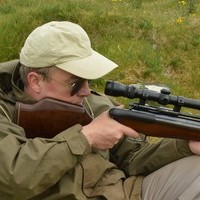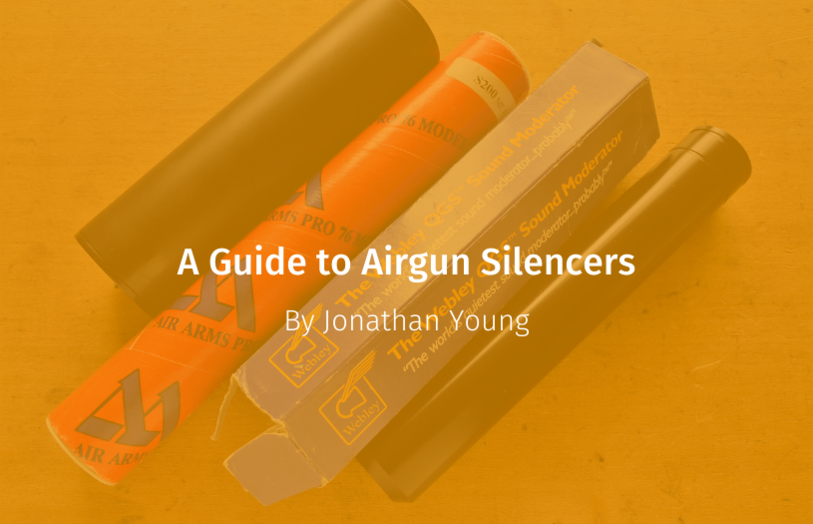
AirMaks Arms at The British Shooting Show
News Events
Create a FREE business profile and join our directory to showcase your services to thousands.
Create my profile now!
Back in the late ‘70s and early ‘80s, the latest must-have new gadget was the silencer and today many consider not using one on any airgun to be a bit daft. A silencer is a very separate part to any airgun barrel and can have a positive and negative effect on the pellet as it fires out of the muzzle. People had in fact been happy with their airguns without this modern gadget for well over 100 years. However, for better or worse silencers were the new ‘in-thing’ and we now live with them daily.
A silencer is simply a tube with some internal baffles that absorb and distort the sound of the muzzle crack. Most people can guess how they arrived years before with the use on real guns. A note just for the novice reader: an airgun silencer as discussed here has nothing to do with proofed firearm silencers that require legal pressure testing and to be officially proofed then entered on a Firearms Certificate. The explosive force of a speeding bullet powered by gunpowder is a world away from a licence-free airgun silencer controlling the mild by comparison ‘phut’ of an airgun pellet.
Custom Adapters, slip-on to 1.2"UNF
A springer can generate a lot of noise but not always from the muzzle. Stood beside a colleague on his backdoor using a BSA Stutzen Airsporter RB2, the hard walls of the house capable of echoing any noise, the retort was very controlled and almost muted. Bearing in mind that a Stutzen or any other carbine airgun with a shorter than average barrel length can show an increase in muzzle blast, this was proof that not all airguns need a silencer.
Many people into hunting and vermin control were reliably informed that a silencer would increase their effectiveness in the field. The irony is that a speeding pellet entering a living target can create more noise on impact than the airgun it came from 35m away. Bang, and watch all the other bunnies sat beside your chosen target scarper.
Silencers do have their uses, however, and this became quickly evident specifically with Co2, pneumatic and pre-charged airguns. Ask a scientist why the muzzle blast from these other forms of airgun generate more noise than the average springer but they do. The pump up pneumatics that were once so popular were even probably to blame for the surge in interest in silenced airguns. Long before pre-charged airguns arrived, and back when Co2 was still restricted, the scary loud pneumatic crack of each and every shot from the so popular Sharp Innova, Crosman and Daisy pump-ups could be heard from gun club to hedgerow up and down the country. Dedicated airgun silencers arrived, designed specifically for low-speed pellet airguns. Brands became big very quickly with names like AirLogic Whisperer, Galway and Parker Hale mentioned in all good 1980s club room banter. At one point everyone was at it making airgun silencers themselves in small workshops and even DIY in garden sheds.
Custom Makarov
For those into DIY, the sky was the limit. Without access to a lathe just made life interesting and more a case of rummaging for parts in unlikely places. An old chair made for a good supply of firm foam, cut to size for baffle use. Looking in the parts bin at the local model shop for shapes that would be the next new thing in silencer technology, that Tamiya F-16 jet nosecone would be just the answer. For a very long period, homemade airgun silencers featured nothing more than a length of plastic or alloy pipe and some hair curlers for the internals. Surprisingly effective are hair curlers.
Much later when restrictions were lifted on Co2 weapons, people discovered any of these can bark like a mad dog even though they’re sometimes giving out less power. A meaty BSA Scorpion spring air pistol running at 4ft/lbs may seem noisy but sat beside a cheap Co2 pistol running on average at only 2ft/lbs will make it sound more like a purring kitten. Air and especially gas pops out the muzzle making a loud crack, well in comparison to a springer. Use a PCP or Co2 indoors and the noise can be irritating at the least and worse, distracting enough to affect your scores.
Silencers appear to be very simple devices; the trick is in how each design absorbs and controls that blast to best effect. This trick on a scientific level relies heavily on mathematics and acoustic engineering. The relationship between length and diameter of the tube, what shape and where any baffles are placed internally and even the exit hole which is usually dedicated to a specific calibre can all have an effect. Many owners may use a general-purpose silencer with a huge gaping exit hole capable of passing a .25 pellet when it may only ever be fitted to a .177 barrel so losing some of the silencing benefits.
Slip-on Silencers - two grub screw fixings versus one
The internal baffles are obviously key to absorbing the noise on any silencer irrespective of how it fits into the barrel. Waffles, cones, washers and spacers, the designs of internal baffles can be staggering and will vary enormously from manufacturer to manufacturer.
However how the silencer is mounted to the barrel can make more impact. With bores aligning with the silencer out of true things can turn disastrous. An off-centre silencer can deflect the pellet making it veer off course missing the target. Worse it may take the silencer with it. Arguments have arisen on the effectiveness of slip-on silencers versus threaded types to avoid the possibility of such anomalies. Surely a barrel that has been machined with a threaded end to take a matching threaded silencer will be much better than an off-the-shelf slip-on job? Not if the only affordable machinist you can find is squinty-eyed and smells of beer.
That said, there’s nothing worse than a sloppy fit push-on silencer jammed onto a barrel that has had some tape wound around it to make the diameter larger. A whole industry has developed around mounting silencers using customised adapters designed to barrel diameter. Many silencers still have a common threaded 1/2” UNF fitting making compatibility easy for direct barrel fitting or to an adapter. Buying one to suit each airgun and its barrel is now the norm. Thankfully so, airgun silencers despite their simplicity now cost more than my 1980s yearly subscription to Star Wars Weekly picked up every week from the newsagents with a packet of Golden Wonder crisps...


